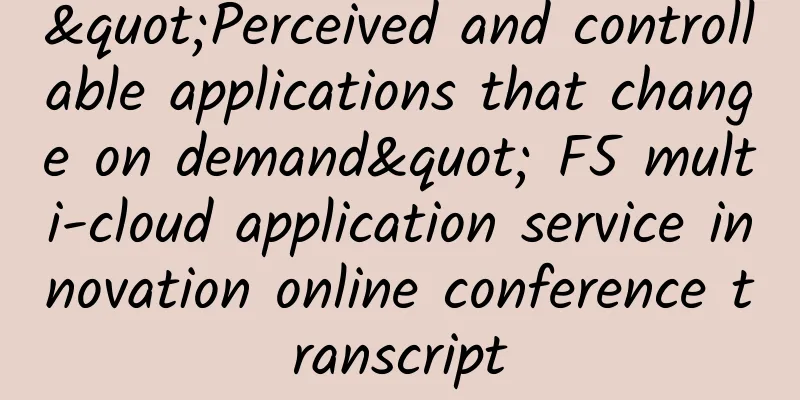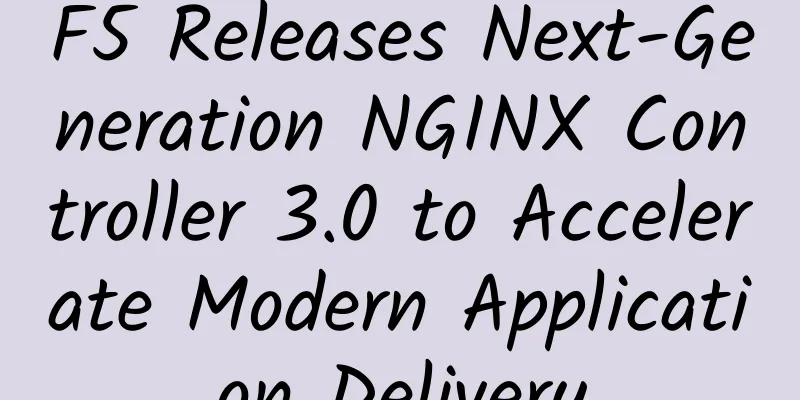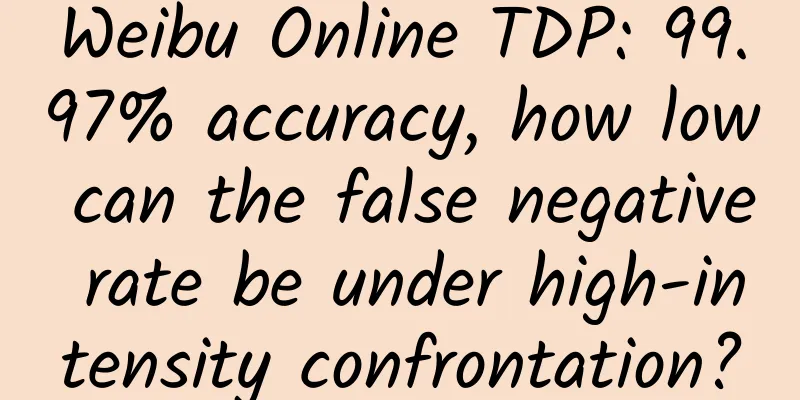"Perceived and controllable applications that change on demand" F5 multi-cloud application service innovation online conference transcript

|
At 10:00 am on December 16, F5, the world's leading multi-cloud application service provider, held an online press conference to introduce its new concept - "Adaptive Applications" and the corresponding innovative overall solutions. In the context of the current accelerated digital transformation, F5 is committed to creating adaptive applications for customers, through automation, security, high performance and insightful differentiated solutions, to achieve the self-growth, self-contraction, self-protection and self-healing of applications, to help customers reduce operating costs and complexity in the process of creating, protecting and running applications, while ensuring an extraordinary digital experience, thereby creating business value.
Interested netizens can click the link below to register and get the viewing link: http://www.f5chinanetworks.com/partner/wechat/datacenter/invite/activityDetails.asp?meetingid=87 The morning agenda is as follows: 10:00-10:05 Opening speech by Zhang Yiqiang, General Manager of F5 China 10:05-10:55 "Perceived and controllable applications that adapt to changing needs" Multi-cloud application service strategy released 10:55-11:25 "Perceptual and controllable, on-demand applications" Multi-cloud application service solution released 51CTO reporters also live-broadcasted the entire F5 Multi-Cloud Application Service Innovation Online Conference, with pictures and text updated in real time. For details, see below: Host: Welcome to the "Perceived Controllable, On-Demand Applications" F5 Multi-Cloud Application Service Innovation Conference. I am today's host, Xiaowu. We meet again. Today, Xiaowu will bring you heavyweight content. As we all know, with the rapid evolution of technologies such as 5G, cloud, and artificial intelligence, users' demand for applications is becoming more and more complex and changeable. Users need to deal with complex application changes and application security protection challenges anytime and anywhere. As a leader in multi-cloud application security and application delivery service technology, F5 has released our new strategic vision and corresponding supporting products, solutions, and services in this environment. Let's start today's conference to give everyone a comprehensive understanding. First, let us welcome Mr. Zhang Yiqiang, General Manager of F5 China, to give an opening speech.
Zhang Yiqiang, General Manager of F5 China Zhang Yiqiang: Hello, everyone. I am Zhang Yiqiang, General Manager of F5 China. Welcome to F5's multi-cloud application service innovation online conference today. Thank you for your trust, attention and support for F5. This year is a special year. The COVID-19 pandemic has brought unprecedented challenges to the global economy and unprecedented opportunities for the development of the digital economy. The digital transformation of enterprises has been accelerated. All walks of life are exploring innovative technologies, which has promoted the explosive growth of new application development. This has also made F5 more determined to position its strategic vision on multi-cloud application services serving the digital age. As a world-class leader in multi-cloud application services, F5 leverages the advantages of NGINX, the world's largest open source application technology, to provide efficient operation support for applications, while focusing on AI technology and achieving excellent business visualization through Shape. As a leader in technology innovation in the industry, F5 clearly understands and masters how to deliver and protect more applications and how to create more value. At today's press conference, F5 will focus on the complex application portfolio, application security, application visualization and other issues faced by customers in the process of rapid digital transformation. Through a people-oriented concept, it will provide a precise and intelligent linear thinking perspective to adapt to the ever-changing environment, fully grasp business processes, and build a new world of perceived, controllable, and on-demand applications to help companies create an extraordinary digital experience. At the same time, F5 China will also focus on cutting-edge technological innovations such as 5G, artificial intelligence, the Internet of Things, and big data engines. Under the guidance of the five major strategic ideas of software, security, cloud, localization, and services, it will make full use of the multi-cloud application service architecture that is aware, controllable, and adaptable to demand, continue to develop in depth in the industry, establish a broad ecosystem, and help Chinese customers optimize their business applications in a more targeted manner, allowing customers to gain more competitive advantages in a multi-cloud environment. We believe that through F5's precise market control, we can work with our customers and partners to transform this year's once-in-a-lifetime challenge into market opportunities and build a digital future together. Thank you all for coming, thank you! Moderator: Thank you Mr. Zhang Yiqiang for your speech. F5's growth, expansion and accumulation in China over the past 20 years reflect our confidence in serving our customers. We firmly believe that under the guidance of the company's new vision, we have the confidence and ability to work side by side with our customers and partners to enter a new world of perceptual, controllable and on-demand applications. So what exactly is the new world of perceptual, controllable and on-demand applications, and why do we need F5's leadership? Let us invite Mr. Wu Jingtao, Chief Technology Officer of F5 Greater China, to explain to you the perceptual, controllable and on-demand applications and F5's multi-cloud application service-level strategy. Wu Jingtao: Hello everyone, I am Wu Jingtao, the Chief Technology Officer of F5's mass market area. Today I will talk to you about the upgraded content of AA. As you all know, F5 proposed the concept of AA, Adaptive Applications, and the story of active-active data centers. But this time we also proposed AA, but its content is different. What we proposed this time is the upgraded version of AA, which is translated into Chinese as perceptual, controllable, and on-demand applications. The first story I want to tell you is that after so many years of computer development, the entire application structure has actually been constantly changing as user needs change, from the early flight-based structure, to the later three-tier structure like Web APP, to the current new structure with cloud-native applications as the main architecture. Its most important goal is to meet the needs of the new generation of consumers born after 1995. What you see on the screen is the number 32% on the far right of the screen, which means that after a bad experience, 32% of users may terminate the service with this brand, and the business will stop. Imagine that when many of our e-commerce and mobile banking services spend so much money on large-scale promotions to attract new users, but users leave because of poor service experience, this is a huge loss. Therefore, as for the vast majority of our F5 customers, there is such a wish, that is, whether we can build a very agile and flexible application with a very good user experience, which can compete with the services provided by the Internet to compete for these post-95 users. So this is actually a goal that our F5 customers hope to achieve. What I want to tell you is that there are very big problems in achieving this goal. In summary, it mainly consists of three aspects. The first aspect is the problem of old and new systems. Generally, F5's customers are basically large customers. Over the years, they have a lot of data centers, applications, and operations and maintenance, and have made huge investments. How to integrate these old applications with new applications is a very long transition process, and this transition cannot be completed in one or two days. It takes years. During this period, how to ensure stability, reliability, high performance and agility, flexibility, dynamics, and agility, how to strike this balance is a very big headache. This is the first one. Second, security. In the past few years, with the development of high-performance computing and cloud computing, many new attack and defense models have emerged, especially for some completely new forms of hacker attacks targeting money, which are very troublesome for many applications. Generally, our bank customers and telecom customers have encountered many problems in the actual response process. This should be the second one. Third, in terms of operation and maintenance, to be precise, in the early days, when customers were building data centers, they all had a very complete operation and maintenance architecture. However, now in the PaaS platform, including in microservices, how to monitor new applications has become very different from before, and how to solve this difference. These three problems are quite obvious in front of our big customers, whether it is banks, telecommunications, or governments. I want to emphasize one thing with you. Their target of competition is the Internet, which can provide lossy services. They can use grayscale releases to partially try. As for traditional F5 users, stability, reliability, and social responsibility are their top priorities. They cannot harm the interests of users or the user experience. They must ensure such service quality because their social responsibility is the first priority. How to ensure this social responsibility while being stable and reliable while competing with the Internet? At this time, we must come up with a brand new concept, and this is the brand new application model that we at F5 hope to help customers build. What is displayed on the screen is F5's new vision. First, after the code business logic is completed, in the process of delivering it to the user, the entire pipeline, the entire delivery process, and the entire data path can provide good application services. This is the first step, of course, in a multi-cloud environment. At the same time, we have built a set of Telemetry capabilities on top of them. This probe-free data collection technology extracts these key business information through F5, builds a new big data platform on it, and uses the cloud to achieve some application insights and visualizations with AI. After having these insights and visualizations, we can control the online application routing and control the online grayscale release through the API interface, thus forming a completely dynamic environment to help customers realize this kind of perceptual controllable and on-demand application. In this way, our enterprise customers, government customers, financial customers, and telecommunications customers can get such a set of perceptual controllable and on-demand applications to ensure social responsibility, social stability, reliability, and high performance, while also coping with various Internet competitions. So this vision has really been proposed by F5 for about two years. With the proposal of this concept, we are building the entire solution step by step. Of course, I believe everyone understands that as one of the industry's leading high-tech companies, we will definitely achieve such a goal through our own research and development or acquisitions. The first thing I want to talk about is acquisitions. In order to serve our customers on a larger scale, F5 acquired NGINX, which is actually the world's largest open source Web Service software. This is one part. The other part is about AI, Shape. We spent 1 billion US dollars to acquire Shape's AI capabilities. I remember when we acquired it, many people thought that F5 spent too much money. But in fact, what I want to tell you is that F5 not only hopes to acquire Shape to achieve such a security protection capability, but we hope to integrate Shape's AI with F5's current online real-time streaming data Telemetry capabilities to form a background AI logic, and in turn to build such a huge system. If you look at it from this perspective, the acquisition of Shape for 1 billion US dollars should not be expensive. You can see that we have completed some capabilities through acquisitions, one is the coverage capability, and the other is the AI capability. Later, especially in China, in order to cooperate with the Chinese market, everyone knows that in 2017, I returned to F5, mainly responsible for investing in China's Phoenix Project as the chief technology officer. For example, we invested in domestic encryption algorithms, invested in private clouds, especially some Openstack research and development, we established our own R&D center, and also worked with various domestic public clouds to build such solutions, to provide products and capabilities to them, and also invested in Chinese local brands, which are completely in line with the localization of this kind of independent and controllable products. In fact, F5 has made a lot of investments in China, hoping to better cooperate with this market, so it is very good. In the past two years, through self-research and investment, we have basically formed such a capability. Today, we are very proud to tell all the customers present here that in this market and in this industry, only F5 can really help you realize such a completely agile and flexible new application architecture, because there are three numbers on the screen. The first one is 400 million. According to the global Web service, there are about 1.2 billion Web Services at present, of which about 400 million are covered by F5's products and services, which means that almost 1/3 of the traffic will flow into F5. You can imagine that with such a large coverage, we can really accumulate enough experience and service capabilities, and with F5's judgment on future development trends, we can form such a possibility of Adaptive Applications. This is the first step, 400 million. The second is 100 million. I am very grateful for the past 20 years, because this year marks the 20th anniversary of F5 entering China. In the past 20 years, our channels and customers have given F5 a lot of support. We were really under various pressures in 2020, but in the end it was a very good settlement. We officially broke through 100 million US dollars in 2020. In China, generally foreign companies with more than 100 million US dollars are basically considered medium-to-large companies, so it is very good. After the 20th anniversary of F5 entering China, such a relatively large and good situation has been formed. What I want to tell you at this point is that F5's customers now cover various industries such as telecommunications, finance, and the Internet. The core technical personnel and service capabilities it has accumulated are far beyond the ability of other companies to easily challenge or surpass, so this is really aimed at demonstrating capabilities. The third one is one second. In fact, when I was writing this content, I was a little hesitant, because when F5 was doing Telemetry, when doing this kind of probeless streaming data real-time data collection, the delay was basically milliseconds. But I believe you understand, whether it is one millisecond, three milliseconds, or five milliseconds, I don't know, because with different applications and different conditions, the delay may not be exactly the same, but it will not be one second. I just want to give you a feeling that it is a millisecond delay. Because after actual testing by our customers, they gave the evaluation that F5 is really a real-time streaming data collection of T+0. Imagine, compared with some traditional big data platforms, getting logs from the database or from the device is basically non-real-time offline data. For risk control, real-time data is required. Indeed, F5 provides a brand new idea and thinking, that is, using online real-time super-hot streaming data collection as a template to form a new form of big data and AI. This is really only F5 can propose at present. So everyone, imagine that with these three numbers as a guarantee, F5 should actually be the best choice to help our clients implement Adaptive Applications. This is something we are really proud of. Next, I want to explain to you that in the past year, our domestic customers have some new ideas about localization and security and controllability. We at F5 sincerely believe that when helping customers solve technical problems, we should not bring new problems. So on the screen, I gave you four different directions for cooperation. The first one is of course F5, a high-tech company with American capital, so the original product of the United States is F5, which can be fully provided to you. Secondly, if your customers have some localization needs and also require domestic independent and controllable products, including the Chinese local brands we have realized, which are OEM+ models. The + part will really have code sharing, and then use local codes to apply for domestic intellectual property registration for such an independent product. We are completely OK with this product, so local brands are acceptable. The third is the need for in-depth localization. Some customers have proposed domestic platforms, software and hardware platforms, including the requirement to open some codes or even all APIs. Customers have such requirements, and we can also implement the third method, which is to cooperate with more in-depth localization. Of course, in the end, I believe everyone understands that F5 acquired NGINX, which is an open OSS software. If possible, we will work with some major customers to do targeted demand research and development. We can develop this part of the code locally and suggest that the customer area do targeted opening. This is also completely possible. At this time, we can better cooperate with the compliance requirements of our domestic information creation. However, I believe everyone can understand that the first two items have been fully completed and can be used at any time. The last two items should be discussed one by one according to the needs of customers, because sometimes the details of the cooperation need to be finalized little by little, and the needs of each customer are completely different. This is probably the situation. Our wish is to help you build such an Adaptive Application to meet the actual application needs of your users born after 1995. Under the condition of helping you to be stable, reliable, and high-performance, and under the condition of social responsibility, to compete with these Internet application services, so that you will not fall behind under the tide of the Internet. This wish is actually very sincere. Of course, while helping you realize this wish, we do not want to raise some new problems. Therefore, when facing the localization strategy, we have also built such four strategies to meet your actual business needs. Later we can really talk about the direction of each technology and the requirements of each detail, because I believe everyone understands that F5 has quite a lot of solutions. In the field of application delivery, I have given you about five solutions and one case. When we talk about application security later, there will also be five solutions and one case. Visualization basically follows this model. Today, when it comes to application delivery, we have brought you five directions. The first is the multi-cloud multi-link resource pool. The second is DDOS, which is really the real demand of most customers. At the same time, we conduct in-depth inspection of applications and self-recovery of faults to build a complete closed-loop service. After that, there is multi-active domestic distributed database support. Many domestic databases need some help in terms of availability and so on. F5 should be said that we have cooperation with all these domestic mainstream distributed databases, especially in several large banks. We have made very meaningful attempts. At present, the operation status is still good. According to our customers, anyway, the server is also localized, the software is also localized, and there may be a slight lack of stability and performance. At this time, a higher technology may be needed to help them achieve high availability, to help them improve performance, to achieve application insight and automation. At this time, F5 should be the best choice, because from the perspective of the entire application investment, even if you spend 1% on F5, it is like buying an insurance. It actually helps customers solve the high availability, high performance, and stability of this application, and the visualization of this application is also solved. This 1% of time is still worthwhile. Next is the PaaS platform and multi-cloud services. As we all know, the general PaaS platform is basically run in a single center. No one will make it a hybrid cloud or multi-cloud service. However, customers, especially financial and telecommunications customers, basically operate in multiple centers. How to implement a cross-platform PaaS in multiple centers? This also requires F5 to provide solutions in this regard. Next, I will bring you a real case. We have done such a dual-center dual-active deployment at an actual customer. In the past, we implemented it through DNS. This time, we hope to implement a dual-center dual-active deployment by combining IP and DNS. This is an architecture diagram of our actual customer. The customer needs to use the PaaS platform to do some agile new business based on the original traditional dual-active data center. However, during the deployment process, they found that they could not deploy PaaS in only one center. They also needed to deploy it in two centers. However, as we all know, there is no dual-center solution for PaaS. What should they do? So the customer asked us, "I have this business requirement. Are you willing to cooperate?" Of course, we all understand that sometimes when customers ask for it, we have no good solution. So we invested our technology and some corresponding resources to cooperate in such a century-long test. After that, we successfully launched the multi-center multi-active PaaS platform. The actual case is displayed on the screen. I won't tell you more about the business value and customer benefits. It has no practical significance. Anyway, in a word, we couldn't do multi-cloud multi-active before, but now we can do it. This is a very big breakthrough. So this case is really good and a very happy thing. Next, we talked about application security. To be precise, a few years ago, F5 generally did not talk about the concept of application security. At that time, F5's main goals were load balancing and application delivery. In the past two years, we have talked more about F5's value in applications and in attack and defense. For example, today, basically around the world, in the field of application attack and defense, especially in technologies like WAF, F5 should be the best in the world. Especially about two years ago, many Chinese governments and financial customers became the targets of application attacks. At this time, F5 has advanced attack and defense capabilities in this area, and it is our responsibility to help customers solve these application security problems. So now we have brought you a logic of security protection in six directions. One is the zero-trust architecture for client access, and then we go to the data center and do simple DDOS attack protection when accessing. Generally, it is mainly based on four layers. Then we enter SSL encryption and decryption. SSLO is a new solution of F5, which is automatic orchestration of SSL. Then we make a full-coverage low-interaction honeypot, and then we build a seven-layer protection platform of WAF. Finally, we actually use the big data platform and AI to do this kind of artificial intelligence attack and defense protection, as well as some anti-fraud business protection. So this should be a full process, from the client to the application end, and even to the attack and defense protection capability of the business end. There are too many things to mention, and time is limited. I cannot introduce them one by one. But I believe that you have heard of F5 agents or F5 vendors' technologies before, and you may have heard of them. Today, I will introduce you to a brand new thing - honeypot. To be precise, honeypot is a technology that should have been around for ten years, or even more than ten years, because I learned about the related technology a long time ago. But this time, F5 provides you with a low-cost honeypot with full coverage. Generally, during the process of attack and defense of customer applications, they will collect methods for protection at all levels. Honeypots are generally customized for the main business. If someone is attacking, they hope to capture the attack through the honeypot, and even track the attack in reverse. This is the working method of traditional honeypots. In the process of protecting major customers in the past two years, they found that any application was attacked, not the main application, which was also a problem for me. Can I deploy a honeypot for the entire network? It is too costly and very complicated. It is really difficult to deal with this matter. So this time, an F5 customer, who I really respect and is an old customer of F5, helped us come up with this idea, saying that since F5 has such capabilities, why don't you productize it and really make a honeypot that covers the entire network. So you can see on the right side of the screen, in the red box, we really got the help of customers to implement this kind of normalized high-performance honeypot system with the goal of full network coverage and the characteristics of screening results based on large data of abnormal user access. And you can see the code above, because to be precise, in the DevOps environment now, we always say this when communicating with customers, it is basically very difficult for engineers nowadays not to know programming. It cannot be said that there is no future, but it is definitely difficult, so they must learn code. You can see that the codes on the screen are completely readable, and can basically be read using our normal language. That is to say, your application needs to track and collect, and you can actually use language to judge and define which key data enters the entire captured honeypot. In other words, this honeypot can be customized for your application, and it can also be used by districts, cities, and counties if you want to cover everything. For example, we can quickly deploy various low-interaction honeypots based on TCP protocol, HTTP protocol, and so on, to implement a honeypot service. This has played a very good role in the actual use of customers. If you are interested, you can really establish this kind of relationship with F5 agents at all levels or with manufacturers, to establish such a communication, and finally realize this, which is in the application security aspect. Just now we talked about that after the entire application logic code is built, the entire process of delivering it to the user includes two major parts, such as application delivery and application security. Therefore, we can basically cover the entire process from code to user, the entire application service in a multi-cloud environment. What we are going to talk about next is the entire process from code to user, on the entire data path. If we can collect the key information of the application, and then build such a big data platform, we can achieve application insights and application visualization in the form of cloud and AI. After making this decision, we can control the online application routing and grayscale release through APJ to build Adaptive Applications. This goal is a very good idea. Now let's talk about the third most important part of today, which is application insights and application visualization. So it reads like this: cloud-based AI analysis and orchestration to achieve application insights and automation. At present, I have standardized it in five aspects. The first one is the big data engine, which is how to collect data. I really have to thank our customer, and I can still mention his name here. It was Gang who taught me. Thank you Gang. This is the second customer I want to thank. During the communication with him, he gave me such a statement, saying that we are now talking about ABC on the user side. AI, Bigdata, and cloud show our leading technology, which is very important. But he said that he still felt that something was missing. The idea brought to him by F5 actually expanded ABC. There is D, which is actually DevOps visualization, and E, which is the final user experience. Because doing ACD is actually a tactical issue, it is not a strategic issue. The real strategic issue is how to deal with Internet applications as a traditional government and financial user, such as Internet+, when competing with Internet applications. This is a strategic issue. In the process of implementation, whether it is AI Bigdata or cloud, they are all tactical issues. The real goal is to provide good E services, that is, user experience services. In the middle, we hope to use DevOps or SRE to implement it in a form to achieve its visualization. He taught me these words at that time, and I will read them out to everyone. They are to improve the ultimate user experience through AI and Bigdata machine learning and visualization of DevOps in the Cloud environment. This is the D and E above F5's ABC. This is really what the customer taught us, how to implement this probe-free data collection technology, and to implement new technologies in real-time super-hot data in streaming data. This is the first part. The second part is about the judgment of application status by active dialing. This is an Internet technology. In most of the application status judgment processes, traditional enterprise users rely on customer complaints to discover problems. The Internet does not do this. The Internet uses a set of active dialing probe systems, which are deployed on the entire Internet. These probes initiate active access to the application and immediately start alarming once any failure in the application is found. Therefore, these Internets already know the application status and user experience before the user complains. This system was rarely used by our traditional telecommunications and financial users before. This time, F5 has also realized it as a product to help customers build such an active dialing platform, which can detect the decline of application status and experience before users complain. This is a very good solution. Next is the visualization of the transaction process and a data source for real-time risk control, the actual details of which will be introduced later. The next step is the automated management of multi-cloud environments. This is mainly based on our actual business needs of a large bank. Our service providers and customers have invested in R&D and finally made it a product. This can be used as a reference for many customers. With private cloud as the implementation template, the application can be visualized in the middle, allowing for flexible scheduling and configuration. This is a very good system. The last one is how to deal with problems after they are discovered and occur. To be precise, in the Internet, everyone likes fully automated processing because it is efficient. However, in F5's traditional customer base, this operation is not allowed, so we basically do it this way, that is, monitoring, then discovering problems, alarming, while alarming, doing root cause analysis, discovering problems, and then making plans to deal with problems first, but at this time, we stop and cannot move, we have to wait, waiting for a human judgment on the customer's side to make an instruction. After the instruction is confirmed, one-click operation and maintenance, one-click cutover, one-click switching, and one-click disaster recovery are all achieved in this way. Semi-automation, although it is only one-click, is not completely automated, that is, a set of automatic control systems with human participation. This is some of the content that F5 hopes to play in the application insights of big data and AI. Because this part is quite new, we will explain it in a little more detail. What you see on the screen now is, what does it mean if we use F5 to collect key business information in the entire data path from code to user? First of all, I will talk to you about the technical basis. F5 is supposed to distribute applications based on key business information, so I can see this data and these key business information. Can I see it and make application judgments based on it while quickly logging it into the big data system in the background? Only two technologies are needed here. The user opens an APP interface, takes a look and clicks the link below. These are two different URLs. I just need to cut off the time of passing through these two different URLs, which is actually how long the user stayed on this interface. This is user behavior analysis, which is very easy to do. Next is user performance management. The first package that the backend application responds to after operation is actually the performance experience of this application server. If a large application has dozens of different APIs to form such an application service, if the performance of an API decreases and causes the entire application to fail, how should it be quickly discovered and solved? At this time, if there is really a manufacturer that can help you to automatically make the relationship logic topology of this application call and help you quickly discover the application performance degradation at a certain point, isn’t this an application performance management? This is the most desired result. Of course, if you have all this data, your data center operation and maintenance will talk about the previous goal in the future, rather than a simple availability or a lot of bandwidth investment, or a lot of server investment. This is equivalent to using financial language to talk about KPIs when reporting internally in the company. This is what we hope to bring you completely different changes. What you are showing you below is active dialing. On the entire big data platform, we first build a platform, sprinkle a lot of access points on the Internet, customize it according to your application, so they start to actively detect it. Once they find any usability problems on your application and performance problems, they can report to the big data platform and enter the alarm stage. Use active dialing to discover the status of your entire application, especially in the process of combining with your DevOps CI/CD, how to compare any new grayscale with the previous version after it is released, or what new and different comparisons are there for its user experience after a new version is released, which is completely possible. So it is really the DevOps active dialing is a completely new topic for customers, and we can help you build it very quickly. This is one. : : : : : : : : : : : : : : : : : : : : : : : : : : : : : : : : : : : : : : : : : : : : : : : : : : : : : : : : : : : : : : : : : : : : : : : : : : : : : : : : : : : : : : : : : : : : : : : : : : : : : : : : : : : : : : : : : : : : : : : : : : : : : : : : : : : : : : : : : : : : : : : : : : : : : : : : : : : : : : : : : : : : : : : : : : : : : : : : : : : : : : : : : : : : : : : : : : : : : : : : : : : : : : : : : : : : : : : : : : : : : : : : : : : : : : : : : : : : : : : : : : : : : : : : : : : : : : : The third one is the agreement. We sent engineers to the customer site. Basically, we analyzed more than 90% of the bank's agreements, even the SASP agreements, and TUXEDO agreements. 90% of the bank's applications can be covered and technology can analyze applications. So, just three sentences, let F5 do real-time probe-free application big data collection, and risk control is really a very good choice. Then there is the visualization of the PaaS platform and the integration with CI/CD. This is also a very simple case. The customer wants to build a PaaS platform. However, after the application is generally entered into the cloud and the application is PaaS, the entire application monitoring, especially the API monitoring, is a brand new topic. The customer only has several requirements. The first one is to use F5 to achieve performance of about six times higher, and there will be a lot of application services to implement. And the most important thing is that the customer uses the visualization of big data in the end to achieve the rating of applications on the entire platform, how many users access, how user performance, how actual delay, and how usability are. All of them are rated for each application. Finally, the data center operation and maintenance group actually scores each user. They help each application score, and the business side will ask how I can improve my score. This is a change. The next one is AIOPs, which can really do an automatic application call logical topology. The application call is dynamic, and finally you can really quickly discover problems. This is called root cause analysis. After discovering the problem, one-click disaster recovery and one-click solution. This is not a technology of F5. We have found a partner in application services. We have basically implemented process tracking for key business, and can achieve the final one-click disaster recovery and one-click processing, which is a really good operation and maintenance automation. The following is the summary stage, because we just talked about application delivery and application security. We went to the big data platform built on them to analyze AI and do application insights, and in turn controlled the entire system to achieve flexibility and implement Adaptive Applications. F5 is based on the application services of the full data path from code to user. Through the information acquisition technology of probeless applications such as Telemetry, it cooperates with the backend big data platform and AI to realize traffic marketing of private domains based on super hot streaming data. It emphasizes private domains to realize application insights and automation, and helps you build such a set of Adaptive Applications to make controllable and changeable applications as needed. This is our vision. In summary, it is true that F5 has passed the acquisition or investment in R&D and self-development, and has basically completed the entire architecture in this market. If all the customers here have various needs in this regard, they can find manufacturers or agents at all levels at any time. Let us do some research in this regard and explore and innovate, because some possible solutions are not complete now. We are fully willing to cooperate to help you build such a set of controllable and changeable applications. While ensuring your social responsibility, the stability, reliability, and high-performance traditional technology, it can help you achieve flexibility, visualization on demand, and PK with Internet applications without losing weight. This is our last wish, and it is also the result we hope to help you build. My content today is over, thank you for your time! Host: Thank you Mr. Wu Jingtao. Now I believe everyone has some understanding of applications that are perceived controllable and changeable with demand. F5 serves applications in the digital age. Through Telemetry's probe-free application information, collection technology and big data platform, and cooperation with AI, it can help users realize private domain traffic management based on ultra-hot flow data, as well as realize application insights and automation. For the Chinese market, combining the five major strategies of software, security, cloud, localization, and service, tailoring for enterprises. F5 will do its best to help enterprises build a vision of perceived controllable and changeable with demand, and achieve application goals that are perceived controllable and changeable with demand. Next, please invite Mr. Zhan Xinwei, director of the Product Business Department of F5 China, to share with you the application and implementation method of perceived controllable and changeable with demand. F5 multi-cloud application service solution, so that we can learn more about this innovative solution, product application and implementation method. Zhan Xinwei: Hello everyone, I am Zhan Xinwei, product manager of F5. F5 has proposed the concept of Adaptive Applications. Customers or our partners, or the industry may be interested in it. What multi-cloud application services and product releases are there to support such an Adaptive Applications solution. So today my speech will introduce to you what new products F5 has to implement under the Adaptive Applications solution architecture. First of all, what you see on the first page is the entire framework of our Chinese name: Perception controllable and application change as needed. In terms of application security and application delivery, there will be a complete AI-based analysis platform of F5 to achieve AI-based security and fraud prevention, including our intelligent operation of AIops, and helping customers to perform digital management, increase digital experience, including subsequent customers, and user data analysis and business services. Under this architecture, what products can be implemented and released? Before entering the details, let me see a few numbers. First of all, what you can see on this page is why F5 and why F5 is suitable for proposing such an Adaptive Applications concept? Today, the data traffic on the entire Internet has increased day by day. So far, about 7,000 petabytes of data are running on the Internet every day. For each application and mobile phone application, more and more companies have also moved their own business management and operations to the Internet, and more applications to support these services. Among these more than 7,000 petabytes, of course, traffic flows through F5? As you can see, it has reached an astonishing 560 petabytes of traffic flowing through F5 devices. F5 devices contain traditional Big IP, and NGINX and Shape we acquired. Many people may be wondering what the 560PB traffic is? We made a comparison and we saw that the huge amount of data traffic it can generate per day is about 1,200PB. Netflix is a very large customer in North America who does American TV series and TV and video services. Its daily data traffic can reach more than 800PB. Every day, you can imagine that the traffic flowing through F5 has reached an astonishing 560PB, which also gives F5 a unique position advantage, and can achieve probe-free data collection, including the analysis of this kind of data later. But if you only have such a few data and F5 has such a unique position, is it enough to do such a thing to publish Adaptive Applications' solution? The answer is definitely not enough. Therefore, F5 has made great adjustments to the products and product lines from the company level, and has also made a lot of layout for future F5 products. On this page, you can see that from code to customers, from applications to customers, is the application security and application delivery that everyone is very familiar with. It contains the traditional BIG-IP family of F5, including NGINX and Shape acquired by F5, as well as the automation platform and ecosystem. In the above layer, when all the data is converged from the data plane and the control plane to the upper layer, how to implement AI-based data analysis, how to display this application, how to turn the analysis results of these data and applications into a suggestion for customer business support, and some insights have come to the topic of our speech today. So, today I will introduce the above four products and product lines, one is our DEOS, which is called digital experience operating system in Chinese. As well as NGINX and Shape acquired by F5. The fourth product is Beacon, a product independently developed by F5. Today I will list the F5 product lines, but I will introduce these products to give you a simple and clear introduction, so that you can have such a concept. First of all, DEOS. The original intention of F5 to develop such an operating system is to improve customers' management of their applications, protect data, and improve their digital experience through such an operating system. This DEOS operating system is actually an AI-based, and then makes full use of the AI engine, and is a platform that is completely deployed on the cloud. Some customers or some listeners may think that in today's market, there are actually many applications that integrate and display data in data collection, and I believe that our customers may have deployed many similar or data collection tools on their networks. Why do we still do such things? I can first introduce to you the difference between the F5 digital operating system platform and the current platforms. First of all, how F5 can realize the data collection of such a digital platform. For some other data collection tools on the market, they are more of a targeted and predefined data collection. The data they collect is completely special purpose, and the application of data is a black box operation similar to that of a black box, that is, the data collected for special purpose is unlikely to be applied to other aspects for data analysis. However, F5's own DEOS can actually analyze all the data collected from F5 in a purposeful way. Secondly, what customers in the market urgently need is an integrated open data collection and analysis system, rather than some closed-loop and black box systems we mentioned just now. The birth of a DEOS like F5 caters to the requirements of the market and customers. : : : : : : : : : : : : : : : : : : : : : : : : : : : : : : : : : : : : : : : : : : : : : : : : : : : : : : : : : : : : : : : : : : : : : : : : : : : : : : : : : : : : : : : : : : : : : : : : : : : : : : : : : : : : : : : : : : : : : : : : : : : : : : : : : : : : : : : : : : : : : : : : : : : : : : : : : : : : : : : : : : : : : : : : : : : : : : : : : : : : : : : : : : : : : : : : : : : : : : : : : : : : : : : : : : : : : : : : : : : : : : : : : : : : : : : : : : : : : : : : : : : : : : : : : : : : : : : After introducing DEOS, let’s take a look at the other two companies acquired by F5. First, Shape, the one that is closest to the F5 family. Before F5 acquired Shape, I believe some listeners may not know what Shape is doing specifically, and some may also hear that Shape is just doing security. In fact, Shape focuses on real-time fraud and security identification, as well as protecting user applications for automated attacks. In the current market for application security, more and more attacks from automation are becoming more and more. In 2020, the online fraud has generated an astonishing US$48 billion. Shape’s experience in this area will be very high, and it is fully reflected. Let’s look at three numbers first. The first is 3 billion. Today, there are 3 billion users’ accounts protected by Shape. The second is 100 million. Every day, 100 million users’ logins are protected by Shape. The third is 250 million. We now estimate that 250 million applications on mobile devices are also protected by Shape. So these three numbers give everyone a very intuitive concept. What kind of market position does Shape have in the current AI-based anti-fraud market? Let’s come down to give you a very general and brief introduction to how Shape achieves protection, but Shape’s product solutions and functions are very rich, not just this page, but what I want to show to you on this page, I hope you can remember two main points, one is Shape’s very powerful AI analysis engine. Based on the AI analysis engine, Shape can realize real-time security and fraud hidden danger identification, and has the ability to learn by itself. It can block reorganized attacks, and can continuously track certain types of attacks for a very long time, realize long-term transactions to customers and user accounts. So in short, Shape carries its powerful AI analysis engine. After entering the F5 family, it can help F5 play a very important role in AI-based security and anti-fraud. After introducing Shape, we came to another company acquired by F5. NGINX was first known to everyone for its massive Web Server applications. F5 acquired NGINX for about two years. After NGINX was acquired by F5, F5 also made some adjustments to NGINX's product line, including NGINX Plus, some security based on NGINX, etc. On this page, you can see that when you mention the current NGINX on the left, you may think more about the layout and architecture of NGINX products in the box diagram on the left. Today, I would like to introduce to you what NGINX needs to do in the future. What is the following points. The first is a lighter WAF, which can even be made into a WAF service that can serve itself. The second is a connection to kubernetes. The third is F5, in the future, it will release independent kubernetesingress, which is also a market leader. After F5 acquires NGINX, F5 will continue to evolve and maintain the part of NGINX OSS. For NGINX OSS, F5 will also create and deliver lighter and more friendly tools for the Dev development team and the Dev Ops team in the future. In addition to the above, NGINX will have two more things in the future. One is that NGINX will release a controller based on SaaS deployment, which is more suitable for controller deployment in the cloud. The last one, NGINX is connected with the existing F5 BIG-IP, and many customers are users of existing BIG-IP. In the future, F5 will associate NGINX with the existing BIG-IP deployed BIG-IP. : : : : : : : : : : : : : : : : : : : : : : : : : : : : : : : : : : : : : : : : : : : : : : : : : : : : : : : : : : : : : : : : : : : : : : : : : : : : : : : : : : : : : : : : : : : : : : : : : : : : : : : : : : : : : : : : : : : : : : : : : : : : : : : : : : : : : : : : : : : : : : : : : : : : : : : : : : : : : : : : : : : : : : : : : : : : : : : : : : : : : : : : : : : : : : : : : : : : : : : : : : : : : : : : : : : : : : : : : : : : : : : : : : : : : : : : : : : : : : : : : : : : : : : : : : : : : : : In addition to providing the visible capabilities of applications, Beacon will also provide a very powerful API. In the future, this API will also allow users to make some presets for their applications through this API, and then read more data and more useful data to apply them to later data analysis. Beacon will also achieve seamless integration and docking with existing F5 products. The most important point is that after Beacon realizes the display and analysis of applications, it can provide insights and insights into the status of customers' application. This is a very useful step to convert real data into a business and into a profit and business. Therefore, Beacon will be a very, very important link in the Adaptive Applications link in the future. The development and technology evolution of Beacon is also somewhat different from the traditional BIG-IP products of F5. It adopts more agile development, which will quickly iterate and deliver new functions to customers' needs and new functions. It also adopts the very popular upgrade-free model of the Internet industry or application development and delivery now. It is to continuously iterate the version quickly, but no longer need to upgrade and maintain the very heavy version as it used to be. : : : : : : : : : : : : : : : : : : : : : : : : : : : : : : : : : : : : : : : : : : : : : : : : : : : : : : : : : : : : : : : : : : : : : : : : : : : : : : : : : : : : : : : : : : : : : : : : : : : : : : : : : : : : : : : : : : : : : : : : : : : : : : : : : : : : : : : : : : : : : : : : : : : : : : : : : : : : : : : : : : : : : : : : : : : : : : : : : : : : : : : : : : : : : : : : : : : : : : : : : : : : : : : : : : : : : : : : : : : : : : : : : : : : : : : : : : : : : : : : : : : : : : : : : : : : : : : I have just introduced so much, and we are now back to the application security and application delivery, because today we have not actually introduced this part in detail. The audience has a better understanding of these detailed contents, such as application security protection, access security, etc., but the systems that support all application security and application delivery are all the major product categories and product lines we just introduced, including BIG-IP, NGINX, AI analysis platform and Beacon, etc. This is precisely because of these, which also supports application security and application delivery from code to customers, from applications to customers. After introducing so much today, the President will give a summary. At the beginning, we mentioned the concept of Adaptive Applications. The first question that comes to mind below this framework is what products and solutions are there to implement. So when we go back to this page, we can give you a more intuitive display and impression. I hope you can remember which products F5 can support such AI-based analysis, which can support AI-based security, AIOps, DEOS, our Shape, Networks and our BIG-IP, will help customers and improve your application and digital experience in the future. So if you have any more detailed questions about F5 products, you are welcome to contact our manufacturers or our partners directly. We are very willing to have in-depth communication with you, convey more products and more good concepts and experiences to you, and have in-depth discussions with you. Thank you! |
Recommend
Yu Xin: What does ofo want to do?
[51CTO.com original article] The 16th China Inter...
5G phones are now online. How long can 4G phones last? Can old phones use 5G networks?
With the advent of 5G technology, 5G has become a...
The benefits of 5G technology for education upgrades
With over 250 million students, India has one of ...
Uncover the mysterious navigation behind the Internet, DNS domain name resolution
In the vast information system of the Internet, D...
The financial network protection action is timely, Ruijie helps large state-owned banks find the correct way to conduct "physical examinations"!
With the continuous improvement of informatizatio...
Experience sharing: key points, difficulties and treatment measures of integrated wiring construction
For the wiring system, the difficulty of construc...
5G makes IP network a trillion-dollar market, and 8 years of network upgrades have been hard on operators
Through the concentrated bombardment of media pro...
Zhang Hao from Ele.me: A food delivery guy sent by AI
[51CTO.com original article] On July 21-22, 2017,...
As 5G technology matures, can it help accelerate the implementation of blockchain?
2019 has become the hot spot for the development ...
How to Develop an Effective Data Center Management Services Plan
Any organization that uses UPS power supplies hop...
Edge computing vs. cloud computing: Which is more efficient?
Cloud computing provides businesses with the oppo...
NIST aims to make frequency sharing more efficient for wireless networks
Machine learning solutions will help different ra...
6G research and development has entered a critical window period. How far is it from commercialization?
Based on the principle of "using one generat...
HostNamaste: $36/year-2GB/50GB/2TB/Los Angeles & Dallas & France & Canada
HostNamaste recently provided several special ann...
China Minsheng Bank and Huawei reach strategic cooperation to build a digital smart bank with technology and finance
[Beijing, China, February 8, 2018] On February 8,...









